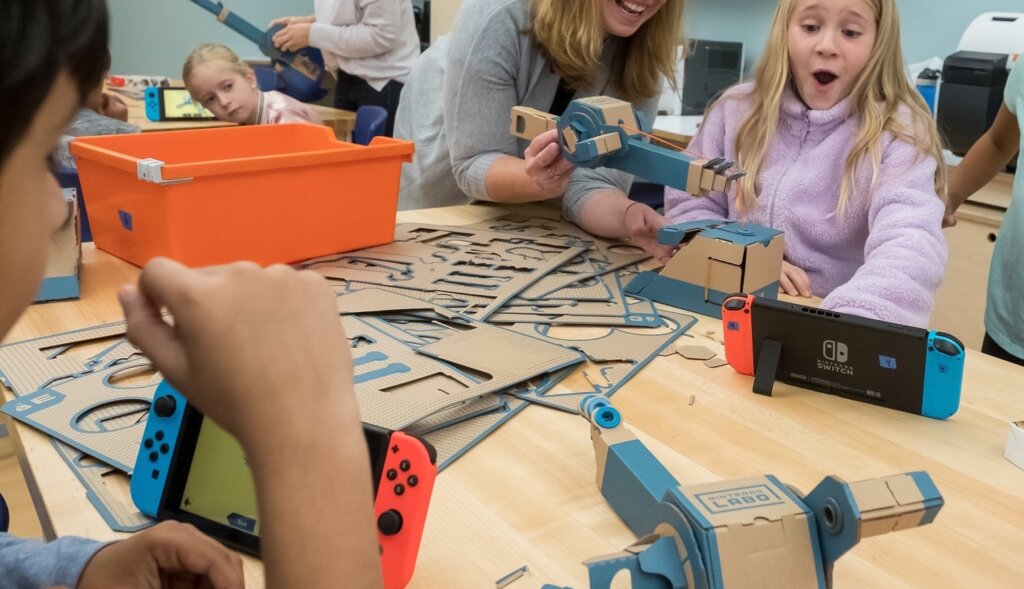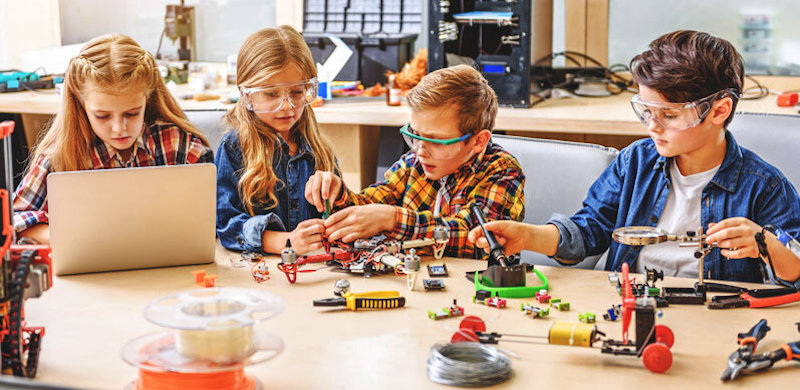STEM and STEAM learning are each great experiences for students. Through these opportunities, they get the chances to build hard and soft real-world skills. STEM and STEAM also, understandably, have a lot in common and educators can use some similar classroom tools and strategies while teaching both. STEAM education, for starters, simply involves adding new opportunities for students to incorporate some artistic design and creativity in hands-on projects. And, when moving from STEM to STEAM, students truly have the chance to display their knowledge using some different techniques.
Adding an 'A' to STEM Learning
Focusing on helping students develop STEM skills through hands-on experiences is very much worthwhile. As evidenced with countless school STEM clubs, programs, and district-wide initiatives, STEM education continues to be a prominent part of preparing today's students. By the same token, however, moving from STEM to STEAM education offers an even bigger boost. Through STEAM learning, students are often able to apply skills they've previously learned to solving problems or designing solutions. Plus, in incorporating artistic elements, they can quickly discover a new sense of creativity.
Bringing elements of STEM to STEAM.
Placing a greater focus on STEAM learning starts with actively passing on messages of this commitment to students. Knowing how to enrich these learning experiences, for example, can help them get there. Since STEAM involves more than simply using high-tech items for designing projects and problem solving, it can help create additional inclusion in any classroom. Students on the shyer side, for example, might feel more comfortable expressing their ideas or taking risks in this new kind of environment. Also, the design process is a big part of the equation for artists. Allowing students to see this can help them make a key connection between STEM and the arts.
Starting with STEM as a base.
Many times, STEM projects and challenges can spark student interest. From there, especially as they get comfortable with using creative problem-solving methods, educators can start introducing them to utilizing STEAM approaches as a way to get even more creative. This initial transition can be a little challenging but the potential rewards are plentiful. Some of this success lies in the technology STEM or STEAM specialists integrate. As long as it helps facilitate creative thinking in students, it's valuable. Finally, another good way to create STEAM learning is through coding. Coding is, of course, a great STEM skill for students to have but these experiences can also show students how thinking about problems like an artist can help them arrive at more efficient and, ultimately, successful solutions.
Transitioning from a STEM Mindset to STEAM
Knowing how the world and economy have evolved over the last couple decades leads a lot of educators and parents to relentlessly push students toward STEAM opportunities. While STEM careers are certainly plentiful (and often fruitful), we recognize they're not for everyone. At the same time, students can develop many of the skills they'll need for success in any STEM industries through STEM experiences. Even if they believe they're more suited for a future in the creative arts, then that's also perfectly good. They may even wind up discovering a new passion or skill set that can help them in a STEM role as well. So, allowing the students to keep their options open and exposing them to both sides can truly help.
An interdisciplinary approach.
Instead of trying to teach students STEAM skills separately, learning experiences have evolved to involve a coordinated approach. This remains the case in both STEM and STEAM education. In many STEM classes, for example, students are routinely tasked with utilizing a variety of skills and approaches to solve complex challenges. And, in STEAM, they're more likely to use a variety of (perhaps different) skills to generate more creative solutions. This also gives students new freedoms to add a personal touch of creativity. For STEAM projects, adding creative and aesthetically pleasing elements can often amplify the results and deepen the overall STEM (or STEAM) experience.
The connection between STEM and STEAM.
Many students form the impression that they're either good at science or art, but not both. Of course, they can be good in either area and might just need help understanding how the two disciplines can wonderfully complement each other. STEAM education also helps illuminate certain links between science and the arts. Understanding the physical components of design materials, for instance, is a strong connection between the two. In order for artistry to exist, there often needs to have been someone inventing one component or another. And, this inventiveness often involves STEAM principles and technologies that allow students to use more artistic elements or creative expression.

Differences Between STEM vs. STEAM
You may have an idea as to why some teachers like to focus on STEAM learning as opposed to STEM. You may also have your own ideas of how to do this and why it is worthwhile. A lot of what it will boil down to is that, in STEM professions, we need a lot of creativity in order to solve complex problems in an efficient and sustainable manner. Whether it's creating art, music, or projects that combine both, leaning on STEAM can truly help students develop the knack for using creativity. As it relates to STEAM as a whole, those subjects and skills students can learn are applicable in many different ways. This even includes—like we mentioned earlier—applying STEAM elements when exploring hands-on projects in STEM.
How creativity affects STEAM.
One of the big differences between STEM versus STEAM is the more active emphasis of the arts. Students often do this by harnessing inspiration from the STEAM fields and applying a similar approach in any STEM learning. The main difference, when it comes to STEAM, is this approach. Their creative process in STEAM learning is absolutely vital. Some might even argue that it's more important than the eventual outcomes. In STEM learning, there's often one or more "correct" ways to solve a problem. In STEAM, however, it's more about applying imagination and creativity, which sometimes might lead to realizations that weren't even on the radar. It's still hands-on learning, though—just with some added artistic elements and benefits.
Using STEAM beyond the classroom.
In STEM learning, students have to figure out various challenges. In STEAM, however, they're often tasked with displaying what they discover in more organized, creative, and artistic ways. So, the way in which they approach how they'll ultimately display this new knowledge is the biggest differentiator. In STEAM learning, students could still take part in hands-on experiences but the opportunities to also apply a growth mindset or STEM mindset is often much greater. STEAM also leads to increased student engagement and can help them establish connections between what they're doing in their classroom and what they could be doing in the real world. And, while STEAM learning isn't intended to help students develop any one specific skill, it's certainly great for empowering them to boost any number of skills that will collectively help them succeed.
STEAM Can Impact Student Achievement
It shouldn't come as a shock, but focusing more on STEAM and not just STEM can help improve academic performance over time. Incorporating STEAM ideas can also create key benefits for children in other areas, too. For example, kids could bolster both their literacy and math skills by simultaneously taking arts-related classes. For years now, educators have been using a STEAM approach in designing the most well-rounded experiences for students. Not only does this help them meet more of the needs today's students have, but it also helps prepare them for all they could have thrown at them in a 21st century career.
STEM and STEAM in career readiness.
The belief that STEM programs belong in all schools lies in the fact that the current economy is so STEM-focused. Students need the skills to eventually become employable in a time with such a huge number of unfilled positions. What educators might not realize, however, is that STEAM experiences can help just as much as STEM experiences. Some people might place a ton of importance on computer programming skills and others might find just as much value in teaching students to approach problems with an open mind and from a new perspective. It sounds simple but, in the art world, perspective can sometimes be everything. A fresh eye and a new angle can help students develop unique problem-solving skills.
Completing the learning experience with STEAM.
Students often benefit from hands-on STEAM experiences just as much as from STEM experiences. True exploration, however, can come into play when teachers introduce STEAM. Adding in their own sparkle of creativity to exploring allows students to learn much more than just science, technology, engineering, and math. They also learn how to apply what they've learned, how to create, and more. All of these, which are elements of STEAM, are also very important in today's economy. A STEAM approach enables students to integrate key problem-solving techniques through the arts. And, as they connect their learning to creativity, it becomes that much more impactful.

Benefits of STEAM Education
As we see, there's certainly a connection between STEM and STEAM education. In fact, many of the same benefits students gain through STEM experiences can be compared with the outcomes of STEAM learning. With STEAM education, new instructional methods have emerged to help teachers truly focus on the more artistic side of education. With this style, they can help students develop various skills that are important in both academic and personal success. We're talking about key skills like creativity, collaboration, or maybe even confidence. And, sooner or later, kids will apply these principles in all of their experiences—whether that's in or out of the classroom.
STEAM problem solving compared to STEM.
We know that creative problem solving is the cornerstone of a STEM career but teaching creativity involves a lot of STEAM too. Simply by encouraging kids to think outside the box, teachers can help them learn to approach tasks differently. Utilizing some new thought processes or actively avoiding some initial instincts are two things that can truly help students gain a broader perspective when it comes to seeking out some creative solutions. This strategy does, however, border on throwing students in the deep end. Doing away with an approach they're confident in, however, can force students to apply their knowledge in a different way to test its efficacy. And, once they see that this, too, can be effective, it could become more routine.
Moving past STEM with STEAM.
The skills students learn from STEAM experiences can be directly applied in their future endeavors. Best of all, STEAM still involves students using technology. This enables them to continue building tech knowledge and proficiencies while they try solving tasks from different angles. There are also various technologies that specifically challenge kids to think creatively. These include art and design tools, which students can use to showcase their new knowledge through creative projects. Also, in STEAM learning, making use of multiple instructional styles can be helpful. Besides reading and hands-on making, teachers can try sharing media with students, posing open-ended questions, or even try performances. Each of these strategies can help students build STEAM skills that will get them ready for anything.
For the latest EdTech, STEM, and 21st century education news, follow us on Twitter and Instagram. Like us on Facebook, too, or sign up for our newsletter for our latest product announcements and offerings. If you have an idea for an Eduporium Weekly theme, send us a message on social media or comment below.



